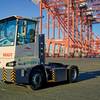Missouri River Basin is Booming
The U.S. Army Corps of Engineers Missouri River Basin Water Management Division is maintaining above normal releases at the four lower dams on the Missouri River. The excess water will allow the Corps to extend the navigation season and provide higher winter releases. Navigation service to the mouth of the Missouri River will now be extended until December 10. Conditions in the basin affected by tributary inflow could extend the season for days after that.
Increases in shipping along the Missouri River are being seen north toward Sioux City for the first time in 11 years. The Siouxland Chamber of Commerce suggested that increased shipping on the Missouri River and all the way to the gulf, complements the air, rail and road infrastructure Sioux City prides itself on.
The port of Kansas City's barge-shipping terminal will reopen after being closed since 2007. The addition of Kaw Industries to the Kansas Port will also bring River Marine Towing back into the basin as well. This means three dedicated tow lines are now operating on the Missouri River.
After a 21 year lapse, MFA, Inc. will have three facilities that are once again operating on the Missouri River. Their first barges arrived in Lexington, MO this week. Bill Dunn, MFA’s director indicated that MFA will be loading out of Lexington, Glasgow and Jefferson City. Hermann Sand and Gravel has taken the lead on the increased shipments of grain coming out of Missouri with the M/V Mary Lynn. To accommodate the increase, Hermann Sand and Gravel has added the M/V Gerald R Engemann to its fleet.
The U.S. Department of Agriculture is predicting a record yield this fall for both corn and soybeans all across the Midwest and the Missouri River will be heavily relied upon to help deliver these products to markets around the world. Mike Steenhoek, director of the Soy Transportation Coalition commented at the recent National Waterways Conference, that moving this year’s crop will be like draining a fire hydrant with a garden hose.
Bottlenecks along our current rail system will increase the importance of the M-70 and the M-29, which is the designation of the marine highway along the Missouri River corridor. Iowa, the largest soybean producer in the country is keeping an eye on the increased shipments on the Missouri River. Concerns continue to rise on the aging infrastructure on the Mississippi being able to support the necessary movement as the U. S. continues to be the world’s largest producer of soybeans. With current budgetary constrictions, the Missouri River is fortunate to have only one lock and dam between Sioux City and the Port of New Orleans. Accounting for 1,877 miles of Marine Highway with only one lock and dam.
“The drought of 2012 increased the value of the tributary flows out of our basin,” said Lucy Fletcher of AGRIServices of Brunswick. Michael Collins, President of the Kansas City Port Authority and Fletcher chair the Missouri River Basin for IRPT and have been working with that groups MO River Revitalization efforts. Fletcher and Collins are working towards taking the Missouri River out of ‘Low Use Waterway’ classification by the USACE. Changing this status would pay huge dividends for the entire Mississippi basin and inland waterway system. In 2012, up to 70% of the flows in the St. Louis Harbor came off of the Missouri River resulting in $7-billion dollars in commodities move on the Mississippi River and that’s tied to 20,000 jobs and $130 million in wages, according to Michael Toohey, President and CEO of the Waterways Council, Inc.













